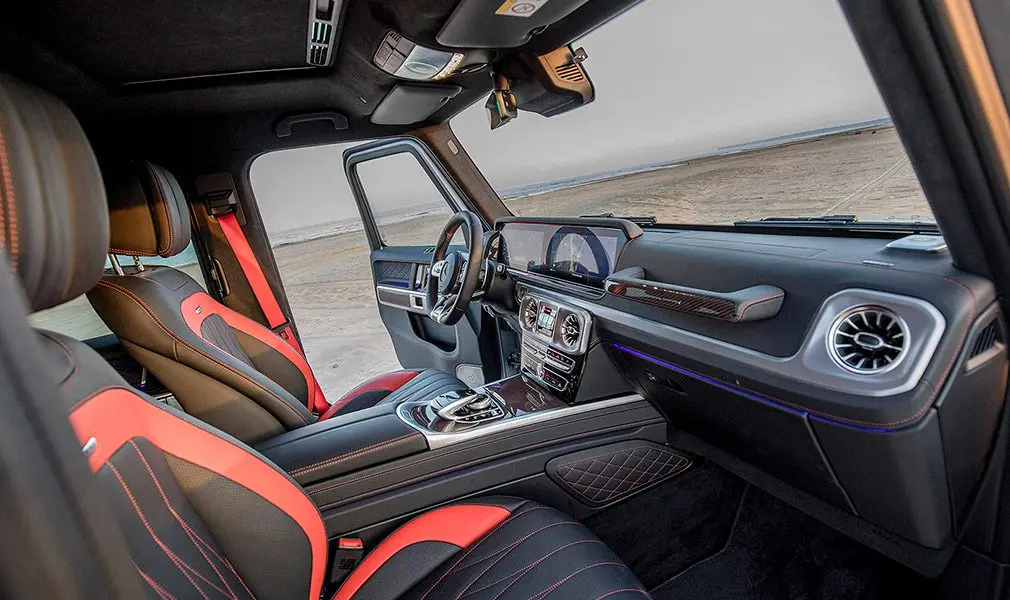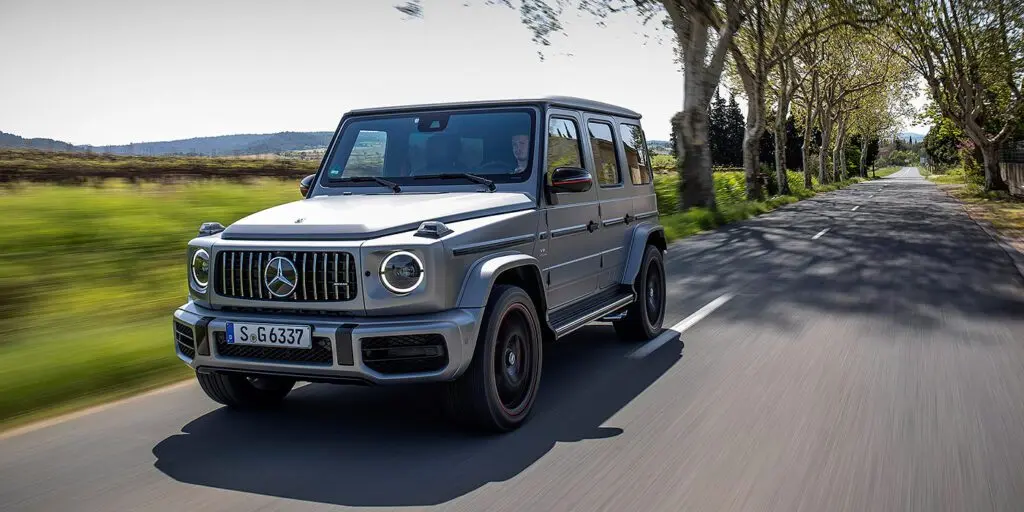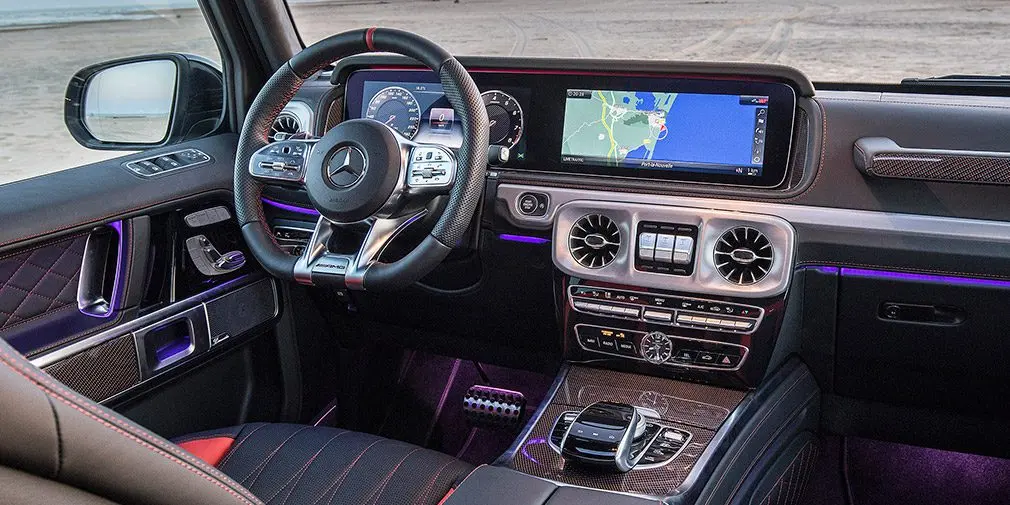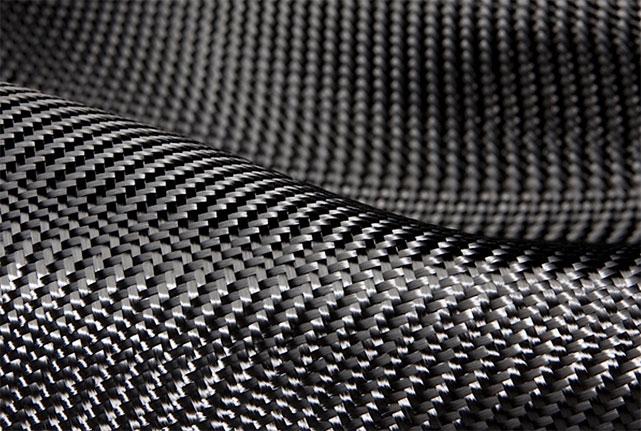
Test drive of the new Mercedes Gelandewagen
Impressions of the new G-Class's outstanding off-road performance, state-of-the-art safety systems and luxurious interior fade as it drives.
It only seems that Gelandewagen has hardly changed with the generation change. You look at him, and the subconscious mind already gives a hint - "restyling". But this is only the first impression. In fact, behind the usual angular appearance hides a completely new car, built from scratch. And it could not be otherwise: who would allow one to swing at the unsinkable image of the icon, erected over the decades into a cult?
However, the exterior body panels and decorative elements on the new G-Class are also different (door handles, hinges and a spare wheel cover on the fifth door do not count). The exterior is still dominated by right angles and sharp edges that now look modern rather than outdated. Due to the new bumpers and arch extensions, the Gelandewagen is perceived more solidly, although the car has increased in size. In length, the SUV stretched 53 mm, and the increase in width was 121 mm at once. But the weight was reduced: thanks to the aluminum diet, the car threw off 170 kg.

But if from the outside the increase in dimensions with the naked eye is almost impossible to notice, then in the cabin it is felt immediately, as soon as you find yourself inside. Yes, the G-Class is finally roomy. Moreover, the stock of space has increased in all directions. Now, even a tall driver will be comfortable behind the wheel, the left shoulder no longer rests on the B-pillar, and the wide tunnel in the center is in the past. You have to sit as high as before, which in combination with the narrow A-pillars provides good visibility.
Good news for back row passengers too. From now on, three adults will comfortably accommodate here and even withstand a mini-journey, which could not have been dreamed of in a previous-generation car. In addition, Gelandewagen seems to have finally gotten rid of the army legacy. The interior is woven according to modern patterns of the brand with controls already familiar from other models. And, of course, it has become much quieter here. The manufacturer claims that the noise level in the cabin has been reduced by half. Indeed, now you can safely communicate with all passengers without raising your voice, even at speeds over 100 km / h.

However, the understanding of the true essence of the new Gelandewagen comes only after you have driven the first bunch of turns on it. "Can not be! Is this a G-Class for sure? " At this moment, you really want to pinch yourself, because you just don't believe that a frame SUV can be so obedient. In terms of steering and steering feedback, the new G-Class has come close to the mid-size Mercedes-Benz crossovers. No more yawing when braking or delayed steering response. The car turns exactly where you want, and the first time, and the steering wheel itself has become noticeably "shorter", which is especially felt in the parking lot.
A small miracle was achieved with the help of a new steering mechanism. The worm gearbox, which honestly worked on the Gelendvagen for all three generations, starting in 1979, was finally replaced by a rack with an electric booster. But with a continuous bridge, such a technique would not work. As a result, in order to teach the Gelandewagen to enter corners with the ease of a car with a monocoque body, the engineers had to design an independent front suspension with double wishbones.

The main difficulty was to raise the attachment points of the suspension arms to the frame as high as possible - this is the only way to achieve the best geometric cross-country ability. Together with the levers, the front differential was also raised, so much so that under it is now as much as 270 mm of ground clearance (for comparison, under the rear only 241 mm). And in order to maintain rigidity in the front of the body, a front strut brace was installed under the hood.
When I asked if it’s time to put the rear continuous axle to rest, Michael Rapp from the Mercedes-AMG development department (who was in charge of tuning the chassis of all versions of the new Gelandewagen) objected that there was no need for this.

“At the front, we were forced to take drastic measures primarily because of the steering. It is not practical to completely redesign the rear suspension, so we only slightly improved it, ”he explained.
The rear axle really received other attachment points to the frame (four on each side), and in the transverse plane it is additionally fixed with a Panhard rod.
Despite all the metamorphoses with the chassis, the cross-country ability of the Gelandewagen did not suffer at all, and even improved slightly. The angles of entry and exit have increased by a nominal 1 degree, and the angle of the ramp has also changed by the same amount. On the off-road training ground in the vicinity of Perpignan, it sometimes seemed that the car was about to roll over or we would tear something off - the obstacles looked so invincible.

But no, "Gelendvagen" slowly but surely drove us forward, overcoming a 100% rise, then a lateral slope of 35 degrees, then storming another ford (now its depth can reach 700 mm). All three differential locks and range are still there, so the G-Class is able to go pretty much anywhere.
And this is where the differences between the G 500 and G 63 AMG versions begin. If at the first off-road capabilities are limited by your imagination, common sense and body geometry, then on the G 63, the exhaust pipes on the sides can interfere with the process (it will be very disappointing to tear them off) and anti-roll bars (they simply do not exist on the G 500). But if the exhaust pipes are just external decorations, then the powerful stabilizers in combination with other shock absorbers and springs provide the G 63 version with simply phenomenal handling on flat surfaces. It is clear that the frame SUV did not become a supercar, but in comparison with its predecessor, the car is controlled in a completely different way.

Of course, cars also differ in power units. More precisely, the engine itself is just unified, and only the degree of its forcing changes. This is a 4,0L V-shaped "biturbo-eight", which we have already seen on many other Mercedes models. On the G 500, the engine develops 422 hp. power and 610 Nm of torque. In general, the indicators are comparable to the car of the previous generation, and the new Gelandewagen is gaining the first hundred in the same 5,9 seconds after the start. But the G 500 feels a lot easier and more confident to accelerate.
On the AMG version, the engine produces 585 hp. and 850 Nm, and from 0 to 100 km / h such a Gelandewagen catapults in just 4,5 seconds. This is far from a record - the same Cayenne Turbo accelerates 0,4 seconds faster. But let's not forget that the Porsche crossover, like any other car in this class, has a load-bearing body and much less weight. Try to remember a frame SUV that takes 5 seconds to accelerate to "hundreds"? And also that thunderous sound of the exhaust system, spread out on the sides ...

Regardless of the version, the new Gelandewagen has become much more comfortable and perfect. Now you don't struggle with the car like you used to, but just enjoy driving. The car has been completely updated - from the front to the rear bumper, while retaining its recognizable appearance. It seems that this is exactly what the clients, including those from Russia, have been waiting for. At least the entire quota for 2018 for our market has already been sold out.
| A type | SUV | SUV |
| dimensions (length / width / height), mm | 4817/1931/1969 | 4873/1984/1966 |
| Wheelbase, mm | 2890 | 2890 |
| Curb weight, kg | 2429 | 2560 |
| engine's type | Petrol, V8 | Petrol, V8 |
| Working volume, cubic meters cm | 3982 | 3982 |
| Max. power, l. with. at rpm | 422 / 5250 - 5500 | 585/6000 |
| Max. cool. moment, Nm at rpm. | 610 / 2250 - 4750 | 850 / 2500 - 3500 |
| Drive type, transmission | Full, AKP9 | Full, AKP9 |
| Max. speed km / h | 210 | 220 (240) |
| Acceleration from 0 to 100 km / h, s | 5,9 | 4,5 |
| Fuel consumption (laughs), l / 100 km | 12,1 | 13,1 |
| Price from, $. | 116 244 | 161 551 |
